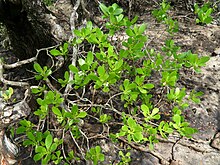| Lumnitzera | |
|---|---|

| |
| Lumnitzera racemosa (flowering) - Kung Krabaen, Chantaburi province, Thailand | |
| Scientific classification | |
| Kingdom: | Plantae |
| Clade: | Tracheophytes |
| Clade: | Angiosperms |
| Clade: | Eudicots |
| Clade: | Rosids |
| Order: | Myrtales |
| Family: | Combretaceae |
| Genus: | Lumnitzera Willd. (1803)[1] |

| |
| Range of Lumnitzera[1] | |
| Synonyms[2] | |
| |
Lumnitzera is an Indo-West Pacific mangrove genus in the family Combretaceae.[3]: 533 An English common name is black mangrove.[4] (However, "black mangrove" may also refer to the unrelated genus Avicennia.) Lumnitzera, named after the German botanist, Stephan Lumnitzer (1750-1806), occurs in mangroves from East Africa to the Western Pacific (including Fiji and Tonga), and northern Australia.[1]
The genus has two species of similar vegetative appearance but with differing flower colour. Lumnitzera littorea has red flowers whereas Lumnitzera racemosa has white flowers. Both species have flat and spoon-shaped (spathulate) leaves with emarginate tips. L. racemosa dominates in the western part of the range and L. littorea dominates in the east. Hybrids occur within the zone of overlap (Lumnitzera × rosea).[1][3]: 587
Three genera of the tropical woody family Combretaceae, Laguncularia, Conocarpus, and Lumnitzera, are found in mangroves but Lumnitzera is the only one to occur in the Indo-West Pacific mangroves, including Australia.[1]
- ^ a b c d e "Lumnitzera". University of Queensland. Retrieved 30 June 2010.
- ^ "Lumnitzera Willd". Plants of the World Online. Royal Botanic Gardens, Kew. Retrieved 25 January 2021.
- ^ a b Excell, A. W. (1948). "Combretaceae". Flora Malesiana. 4 (5): 533–589 – via Naturalis Institutional Repository.
- ^ USDA, NRCS (n.d.). "Lumnitzera". The PLANTS Database (plants.usda.gov). Greensboro, North Carolina: National Plant Data Team. Retrieved 23 June 2015.